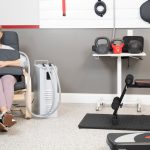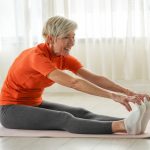I came across a video online of a toddler groaning as if in pain while she bent over to pick up a toy. It was captioned “This is how you know your parents are old.”
While the video was hilarious, it highlights an ever-growing problem: chronic pain and inflammation. Most people deal with one or the other daily.
Many reach for a bottle of medication to ease pain, but those medications may lead to unwanted side effects. I decided to research natural solutions to reduce pain and inflammation.
Is Inflammation a Bad Thing?
This question may have never crossed your mind. Inflammation, by nature, is uncomfortable and alerts you to something wrong in your body. However, inflammation may be a double-edged sword, depending on the type.
Acute Inflammation
Acute inflammation may be painful but is actually beneficial to the body. If you are injured or have an infection, your body responds to it with acute inflammation. Your body is trying to balance itself and return to normal. Without this crucial natural reaction, infections and illness would quickly take over.
Acute inflammation shows up as reddened skin, pain, tenderness, puffy or swollen tissue, and skin that feels warm to the touch.
Chronic Inflammation
Chronic inflammation is not beneficial and in fact causes tremendous harm. Finding out if you have chronic inflammation may require a blood test.
Chronic inflammation is generally a companion to illnesses like cancer or autoimmune disorders. It can show up as a result of exposure to pollution and toxic chemicals. It can even result from excess stress or body weight.
Because it can happen from so many different things, the symptoms don’t always follow the same pattern. However, a person with chronic inflammation generally has fatigue, pain or stiffness, or a rash.
How to Deal with Chronic Inflammation and Manage Pain
There are many different natural ways to deal with pain and inflammation.
Take care of your gut.
The medical community generally agrees that 70 to 80% of the body’s immune system is in the digestive system. A lack of quality nutrients in your diet directly affects your immune system. A poor immune system can, in turn, lead to inflammation.
Every digestive system needs different support, so you will need to figure out what works best for you. Avoiding fried food, refined carbs, excess sugar or fake sugar, trans fats, and overly processed foods will benefit everyone. They can truly wreak havoc on your digestive tract by promoting inflammation.
Exercise consistently.
Focus on finding ways to incorporate movement into your day, even if it’s only an afternoon walk. For people who are fighting illness or carrying excess weight, overdoing it may make you feel worse. Start slow, and set realistic goals rather than going for the gold.
Don't forget to rest.
Lose a few pounds.
If you’re carrying additional weight, the pressure on your joints may cause an increase in your inflammatory markers. Sometimes, genetics, hormonal imbalance, or illness make this difficult. Make choices every day to live a healthier lifestyle, no matter what the scale says.
Practice gratitude.
In addition to proven physical and emotional benefits, having a positive attitude can help to lower your stress. Lowering stress is a way to naturally reduce inflammation. Try to practice gratitude by journaling, meditating, and reflecting on things in your life you are grateful for.
Dietary Support
Whenever you make substantial adjustments to your diet or start taking new vitamins and supplements, always check with your doctor first. Even natural foods can sometimes yield unwanted side effects depending on your body and its needs.
Rosemary
Rosemary oil can be mixed with a carrier oil and rubbed onto sore areas to reduce pain and inflammation. Studies also show that dried rosemary taken internally may work on the brain’s opioid receptors, helping to reduce pain levels. Experts recommend taking 2 grams daily and no more than 4-6 grams per day. Rosemary can have side effects when taken in large doses and interact with various prescription medications.
Ginger
Ginger has been used for centuries for pain relief and inflammation. It can be used topically, taken as a capsule or tincture, used during cooking, or drank as tea.
Turmeric/Curcumin
Curcumin is a compound in turmeric, and studies have shown that it may reduce pain and inflammation. Some experts say to take it with piperine from black pepper. Other sources say that piperine can upset the digestive tract and recommend taking it with a digestive enzyme instead.
Anti Inflammatory Diet
Foods containing large quantities of antioxidants and polyphenols are known for reducing inflammation. Leafy greens, fatty fish, berries, and Mediterranean diet foods like olive oil, vegetables and whole grains are among these. The good news is you may already be including some of these in your diet!
Pro Tip: Here is a workaround if your digestive tract struggles with raw vegetables. To preserve the most nutrients possible, cook the vegetables in a pressure cooker with a bit of water. Make sure to drink the cooking water afterward to maximize the benefits of the vegetables.
Omega 3 Fatty Acids
These are widely known for their anti-inflammatory benefits. Many people take fish oil supplements, but these can cause digestive upset. As an alternative, include fatty fish, seaweed, chia seeds, ground flaxseeds, walnuts and edamame in your diet.
Helpful Modalities
You may feel as though you’ve tried everything, but these ancient wellness practices may surprise you.
Acupuncture
This ancient Chinese therapy is gaining popularity as a way to reduce inflammation. Research suggests that various causes (like illness) can trigger a wave of cytokines to be released. This flood of cytokine pushes inflammation levels up.
Acupuncture may reduce this sudden rush of cytokine and cause inflammation to decrease. Pain may also decrease as the acupuncture points are activated, affecting your endorphin and serotonin levels.
Yoga
This exercise modality increases flexibility and provides many of the same pain-relieving and anti-inflammatory benefits as standard exercise. Deep abdominal breathing also has many benefits like boosting your oxygen levels, reducing your heart rate, and helping you relax.
Hot/Cold Therapy
Applying heat to muscles and joints helps to relax and soothe them. Do not use heat if an area is swollen, as the heat can cause the swelling to get worse. If there is no swelling, use a warm bath, heating pad, hot rice bag, or heat wrap to apply heat.
Where there is swelling and inflammation, cold or ice therapy can reduce them and help temporarily relieve pain. Cold showers, ice baths, and ice packs can help you accomplish cold therapy. Remember to only use ice for 15-20 minutes before giving the area a break.
Massage
A regular massage can help loosen sore muscles and joints and increase blood flow throughout your body. For some experiencing chronic pain, massage therapy may be uncomfortable or less relaxing. If this is a concern for you, discuss style and pressure with your masseuse in advance.
Grounding
Don't Give Up
If you are struggling with pain and inflammation, know that there are plenty of solutions to try including many natural options. The options covered in this blog post barely scratch the surface.
















